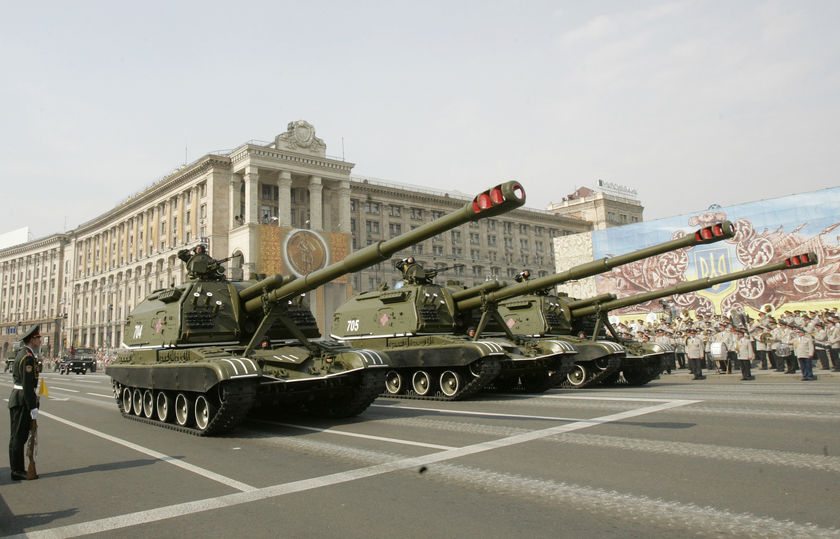Russia has the world’s second-ranked military after former Cold War foe the United States.
The armed forces in Ukraine, a former republic in the ex-Soviet Union, are much, much smaller.
But numbers don’t tell the whole story. Other factors come into play in weighing which side might get the upper hand should war break out with a Russian invasion.
Chief among them is the fact that Moscow cannot send its entire military into Ukraine without leaving other parts of Russia defenceless.
And then there is Ukraine’s home advantage, with much of the population opposed to Russian domination by force.
Balance of power
On top of its 130,000 serving troops, Ukraine could call up reservists to boost its total defensive force to around one million.
Ironically, many of Ukraine’s barracks and bases are positioned for a Cold War-era threat from the west, not the east where Russian forces would come from.
But it already has a deployment of unknown size operating in the east to counter pro-Kremlin rebels, and could send more relatively quickly.
Russia has a much bigger national conventional force of 845,000 — but maybe only a third of that could be diverted to an invasion of its western neighbour.
Moscow, after all, also has to think about the Caucasus and Central Asia threats on its southern flank, maintain anti-NATO positions elsewhere in the west — and keep its hold on Crimea.
Russia has deployed 40,000 soldiers to the border with Ukraine, according to NATO. Ukraine has some 4,000 tanks and 6,400 armoured vehicles to Russia’s total 15,500 tanks and 27,600 APCs — handy in the relatively open terrain in the east.
Russia also has six times the multiple-launch rocket systems that Ukraine has, and some 2,000 combat aircraft to Ukraine’s 300. There is also an imbalance of helicopters that provide support for ground forces: Ukraine has around 150, while Russia has more than 1,000.
Home ground advantage
For all the numerical superiority, Russia would face the risk of venturing into territory where much of the population is hostile to it — an environment that could eventually lead to asymmetrical guerrilla warfare against an occupying force.
Although parts of the Russian-speaking east certainly seem more sympathetic to Moscow than to the new, Western-backed leadership in Kiev, that does not mean all or even most of the east wants to come under the Russian flag, as was the case in Crimea, annexed by the Russian Federation last month after a hasty regional referendum.
A poll published a week ago and carried out by Kiev’s Institute for International Sociology suggested that 70 percent of the population in Ukraine’s east were against Russian control. Many of the respondents, though, said they were in favour of autonomy.
To get around some of the nationalistic obstacles, Russia could expand the strategy that Kiev and the West accuse it of using already: deploying fighters covertly, without insignia, and fomenting unrest under the banner of “local self-defence units”. It could also minimise the military burden by taking just a corridor of territory, say from the Russian land border to Crimea.
Economic factors
Both countries are ill-placed economically to go to war.
Russia is expected to tip into recession this year. Sanctions threatened by the G7 group of wealthy nations, with the United States in the lead, will likely push its economy further underwater. On top of that, if it takes Ukrainian territory, it could end up being financially responsible for running it, increasing the drain on state spending.
Ukraine, meanwhile, is virtually bankrupt and is waiting on an IMF bailout worth $14 billion to $18 billion to be decided next week, part of a $27 billion (20 billion euro) rescue package mounted by the World Bank and Western powers.
What about Western sanctions?
The US and EU threat of more sanctions is having no apparent effect on Russian President Vladimir Putin’s policies towards Ukraine. If he decides to order an invasion, sanctions alone will not deter him. And NATO — of which Ukraine is not a member — is not about to step in to challenge his forces.
But US Treasury Secretary Jack Lew, who is tasked with implementing the American sanctions, acknowledged their limits, saying that sanctions were a long-term strategy to be used “in a world where you can’t compel another leader how to make a decision”.
“Frankly, the goal is to hurt the Russian economy while doing the least damage necessary to the US and the global economy. And I think, we’ve made clear we’re prepared to take tougher actions and prepared to absorb the consequences of that if we need to,” he said on US radio.









